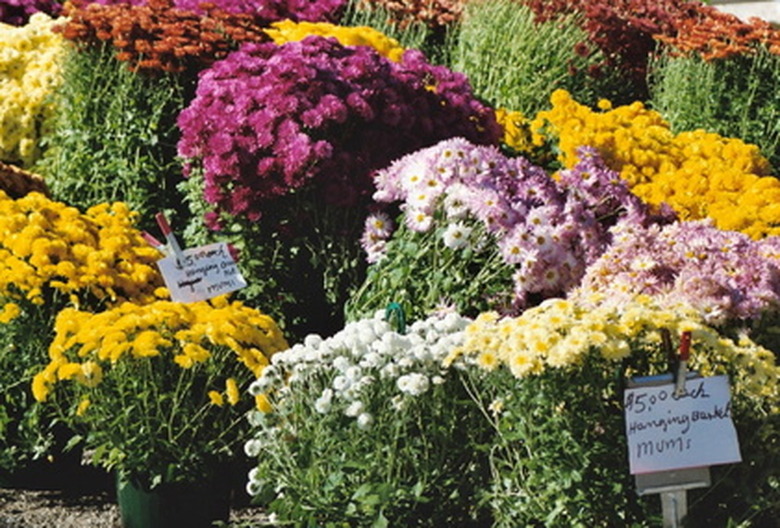Types Of Mum Flowers
Swedish Botanist Karl Linnaeus named chrysanthemums, originating in Asia, in 1753. There are so many varieties of mums, from the Compositae family, that a classification system was developed to help with identification. Mums can be grown from seed, cuttings or clump division and thrive in locations providing full sun and nutrient-rich soil with good drainage.
Incurves
There are three types of incurve mum: irregular, regular and intermediate. Growing on short to medium plants, incurve blooms form orbs of compact upward-curving petals. Irregulars are the largest blooms, up to 8 inches in width, in the Chrysanthemum genus. Irregular incurve cultivars include Blushing Bride, River City and Whiteout. Regular incurve mums form smooth, compact, globular blooms. Regular varieties include Gillette, George Couchman and Moira. Intermediate incurve blooms have shorter, less compact petals. Intermediate cultivars include Candid, Pat Lawson and Suzanne Etheridge.
- Swedish Botanist Karl Linnaeus named chrysanthemums, originating in Asia, in 1753.
- Irregulars are the largest blooms, up to 8 inches in width, in the Chrysanthemum genus.
Reflex
Reflex mum varieties produce medium to large blooms. Petals curve downward and overlap to resemble the pattern of bird feathers. Growing on medium-sized plants, popular reflex varieties include Doreen Statham, John Lowry and White City.
Decorative
Decorative mums, which grow on short plants, produce flattened, open blooms. Petals on decorative mum varieties extend in two directions, with upper petals curving in and upward while lower petals extend outward. Commonly used in cut flower arrangements, decorative mum varieties include Indian Summer, Killeen, Resomee and Tobago.
Pompon
Pompon mums are another cut-flower arrangement favorite, producing sprays of delicate, compact blooms. Ranging in size from 1 to 4 inches, pompon mum cultivars include Lavender Pixie, Moonbeam and Yoko Ono.
- Reflex mum varieties produce medium to large blooms.
- Ranging in size from 1 to 4 inches, pompon mum cultivars include Lavender Pixie, Moonbeam and Yoko Ono.
Single and Semi-Double
Single and semi-double mums resemble daisies, sporting compact, center discs surrounded by one or more rows of extending ray florets. Some popular single and semi-double mum varieties include Domingo, Icy Island, Peggy Stevens and Rage.
Anemone
Anemone mums produce blooms with extended rows of ray florets surrounding a raised, globular center. Useful for outdoor beauty and cut flower arrangements, anemone mum varieties such as Cloverlea Sunshine, Purple Light, Shock and Vesuvio provide color and interest.
Spoon
Spoon mums, similar to semi-doubles, have several rows of ray florets with a flat center disc, growing on tall plants. The petals on spoon mums, however, end with a spoon-shaped curve. Some popular spoon mum varieties are Fantasy, Kimie and Redwing.
- Single and semi-double mums resemble daisies, sporting compact, center discs surrounded by one or more rows of extending ray florets.
- Useful for outdoor beauty and cut flower arrangements, anemone mum varieties such as Cloverlea Sunshine, Purple Light, Shock and Vesuvio provide color and interest.
Quill
Quill mums offer decorative blooms filled with spiky, tubular florets that end with the curved spoon shape or a downward curl. Quill mum varieties include King's Delight, Lola, Seatons Ashleigh and Muted Sunshine.
Spider
Spider mums, also called Fuji mums, produce blooms packed with long, threadlike florets that tend to coil at the ends. Growing on medium plants, spider varieties such as Chesapeake, Fleur De Lis, Icicles and Senkyo Kenshin add exotic beauty to the garden.
Brush/Thistle
Brush and thistle mums are exotic blooms with long, tubular petals that extend upward, in the shape of a broom or brush, or twist and droop. Popular brush and thistle mum varieties include Aoi, Cindy, Cisco and Saga No Yuki.
Unclassified
Unclassified mum varieties are those that combine characteristics of the other mum classes, providing exotic and unusually-shaped blooms. Unclassified cultivars such as Lili Gallon, Lone Star and Pacificum are popular choices for gardens and cut flower arrangements.
- Quill mums offer decorative blooms filled with spiky, tubular florets that end with the curved spoon shape or a downward curl.
- Growing on medium plants, spider varieties such as Chesapeake, Fleur De Lis, Icicles and Senkyo Kenshin add exotic beauty to the garden.
